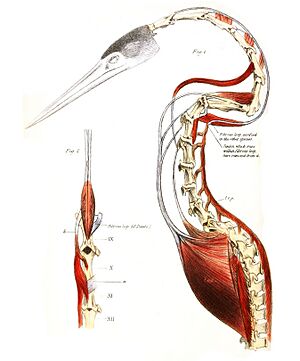Darter facts for kids
Quick facts for kids Darter |
|
|---|---|
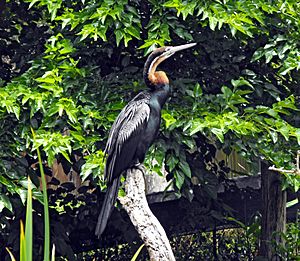 |
|
| Male African darter Anhinga rufa |
|
| Scientific classification |
|
| Kingdom: | Animalia |
| Phylum: | Chordata |
| Class: | Aves |
| Order: | Suliformes |
| Family: | Anhingidae Reichenbach, 1849 |
| Genus: | Anhinga Brisson, 1760 |
| Type species | |
| Plotus anhinga Linnaeus, 1766
|
|
| Species | |
|
Anhinga anhinga |
|
 |
|
| World distribution of the family Anhingidae | |
| Synonyms | |
|
Family-level: Genus-level: |
|
Darters are amazing waterbirds found mostly in warm, tropical places. They are also called anhingas or snakebirds. These birds belong to a single family called Anhingidae, with only one group (genus) called Anhinga.
There are four types of darters alive today. Three are very common, but one is rarer and needs protection. The name snakebird comes from their long, thin neck. When they swim, their body is underwater, and only their neck sticks out, looking just like a snake!
The name "darter" describes how they catch food. They use their sharp, pointed beak to quickly stab fish underwater. The American darter is often called an anhinga. Sometimes, people in the southern United States call it a "water turkey."
Contents
What Do Darters Look Like?
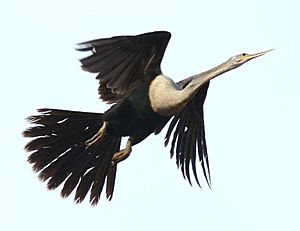
Darters are large birds, usually about 80 to 100 centimeters (31 to 39 inches) long. Their wings can spread up to 120 centimeters (47 inches) wide. They weigh around 1 to 1.3 kilograms (2.3 to 3 pounds).
Male and female darters look a bit different. Males have black and dark-brown feathers. They have a small crest on their neck and a larger beak. Females have lighter feathers, especially on their neck and belly. They are also a little bigger overall.
Both male and female darters have grey spots on their long shoulder feathers and upper wing covers. Their beak is very sharp and pointed, with jagged edges. Darters have fully webbed feet, which help them swim. Their legs are short and set far back on their body.
Their bare skin parts change color throughout the year. When they are breeding, the skin around their face turns a bright turquoise color. Their eye color can also change seasonally, from yellow to red or brown. Baby darters are born without feathers but quickly grow soft white or tan down.
Darters make different sounds. They click or rattle when flying or sitting. In their nesting areas, adults make croaks, grunts, or rattles. When breeding, they might make a "caw" sound or hiss. Young darters squeal or squawk to communicate.
Where Do Darters Live?
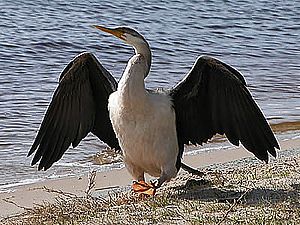
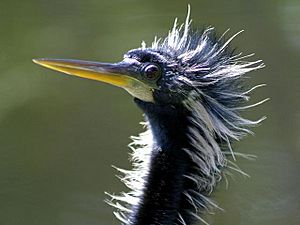
Darters mostly live in warm, tropical areas. They can also be found in subtropical and warm temperate regions. They prefer fresh water like lakes, rivers, marshes, and swamps. Sometimes, they are seen in salty water near the coast, like in bays or mangrove forests.
Most darters stay in one place and do not migrate. However, those living in cooler areas might fly to warmer places for winter. Darters are good at soaring and gliding in the air. When they flap their wings, they look a bit clumsy. On land, they walk with high steps, often spreading their wings to keep balance, much like pelicans.
Darters often gather in groups, sometimes with up to 100 birds. They might also hang out with storks, herons, or ibises. Even though they nest in colonies, they are very protective of their own nest. Breeding pairs, especially males, will stab any other bird that comes too close with their long neck and beak.
The Oriental darter is a species that is close to being endangered. Losing their homes and human activities like collecting eggs or using too many pesticides are the main reasons why darter numbers are going down.
What Do Darters Eat?
Darters mainly eat medium-sized fish. Sometimes, they also eat other water animals with backbones or large water insects. These birds dive underwater using their feet to swim. They quietly sneak up on their prey and then use their sharp beak to stab the animal.
They don't dive very deep. Darters can stay underwater easily because their feathers get wet, they have small air sacs, and their bones are denser. They have a special hinge-like part in their neck. This allows them to shoot their neck, head, and beak forward like a spear to catch food.
After stabbing their prey, they come back to the surface. They toss the food into the air and catch it again so they can swallow it head-first. Like cormorants, darters have feathers that get wet when they dive. To dry their feathers, they go to a safe spot and spread their wings wide.
Darters lose all their main flight feathers at once. This means they cannot fly for a short time.
Who Hunts Darters?
Large meat-eating birds are the main predators of darters. These include birds like the Australian raven and house crow. Birds of prey, such as marsh harriers or Pallas's fish eagle, also hunt them. Crocodiles have also been known to eat darters.
However, many animals know it's risky to try and catch a darter. Their long neck and pointed beak, combined with their "darting" attack, make them dangerous. They will even move towards an attacker to fight instead of just defending or running away.
Darter Reproduction and Life Cycle
Darters usually breed in colonies, sometimes mixed with cormorants or herons. They stay with one partner for at least one breeding season. Males perform many different displays to attract females. They might raise their wings, bow, snap their beak, or offer twigs to a potential mate.
To make their bond stronger, partners rub their beaks or wave their necks together. When one partner takes over at the nest, they use similar displays.
Breeding happens at certain times of the year in cooler areas, usually peaking in March or April. In warmer places, they can breed all year round. Their nests are made of twigs and lined with leaves. They build them in trees or reeds, usually close to water.
The male usually gathers the nesting materials. The female does most of the building. Nests are built quickly, often in just a few days. Darters usually lay about four eggs, but it can be anywhere from two to six. The eggs are pale green.
Eggs are laid within 24 to 48 hours and hatch after 25 to 30 days. The parents keep the eggs warm by covering them with their large webbed feet. This is because they don't have a special "brood patch" like many other birds. If there isn't much food, the last baby to hatch might not survive.
Both parents help care for the young. When they are very young, the babies are fed partly digested food. As they get older, they eat whole food items. After they learn to fly, the young are fed for about two more weeks while they learn to hunt on their own.
Darters can start having babies when they are about two years old. They usually live for about nine years. The longest a darter has been known to live is around sixteen years.
Darter eggs are sometimes collected by people for food. The adult birds are also eaten occasionally. Like other fish-eating birds, they don't taste particularly good. In some places, darter eggs and young birds are collected to raise them. Some nomadic people in India used to train tame darters to help them catch fish, similar to how cormorants are used. This old tradition is slowly disappearing as more people settle down.
Darter Family Tree and History
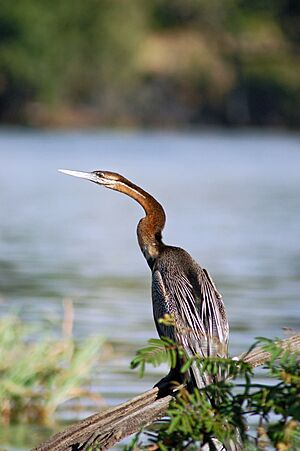
The group (genus) Anhinga was named in 1760. The American darter (Anhinga anhinga) is the main species of this group. The word Anhinga comes from a language called Tupi. In their old stories, ajíŋa meant a bad forest spirit, sometimes called "devil bird." This name was later used for the bird.
Darters are very closely related to cormorants and gannets. These three bird families are often grouped together. Darters and cormorants look very similar in their bones. Some scientists even thought darters should be part of the cormorant family.
These bird families also share similar ways of showing off, especially when trying to find a mate. For example, darters, like cormorants, use a bone in their throat to stretch their neck pouch during displays. Male darters lift their wings when displaying, similar to cormorants and gannets. However, their unique alternating wing-waving is special to darters. When walking, darters often spread their wings for balance, which is also unique to them.
Scientists used to group darters with pelicans and other "higher waterbirds." But now, they know that many of the shared traits, like webbed toes, developed separately in different bird groups. So, darters, cormorants, and gannets are now placed in their own group called Suliformes.
Living Darter Species
There are four types of darters alive today, all in the Anhinga group:
- Anhinga or American darter, Anhinga anhinga
- Oriental darter or Indian darter, Anhinga melanogaster
- African darter, Anhinga rufa
- Australasian darter or Australian darter, Anhinga novaehollandiae
Some old bones found in Mauritius and Australia were once thought to be extinct darters. But later, scientists found out they were actually bones from different types of cormorants.
Darter Fossils
We have found many darter fossils. The oldest darter fossils are about 18 million years old. These ancient darters already looked quite similar to the ones we see today. Scientists believe darters first appeared around 40 to 50 million years ago.
Many different types of ancient darters have been found. Some of these extinct darters were very large. It is thought that the darter family might have started in South America, as many fossils have been found there.
Over 20 million years, the smaller types of darters have survived and spread across continents. Their ability to fly long distances helped them survive. The warmer areas around the equator seem to have been key to their success.
See also
 In Spanish: Aníngidos para niños
In Spanish: Aníngidos para niños




